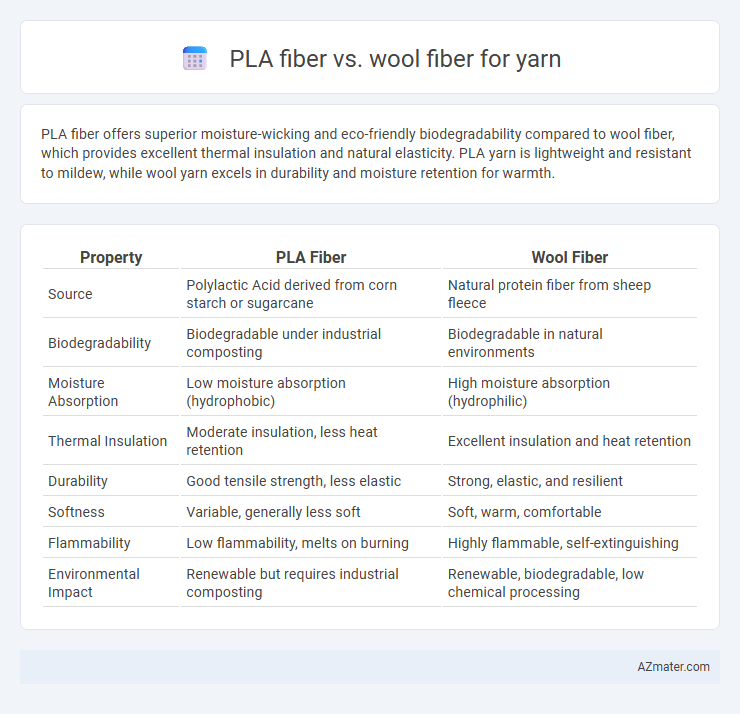PLA fiber offers superior moisture-wicking and eco-friendly biodegradability compared to wool fiber, which provides excellent thermal insulation and natural elasticity. PLA yarn is lightweight and resistant to mildew, while wool yarn excels in durability and moisture retention for warmth.
Table of Comparison
| Property | PLA Fiber | Wool Fiber |
|---|---|---|
| Source | Polylactic Acid derived from corn starch or sugarcane | Natural protein fiber from sheep fleece |
| Biodegradability | Biodegradable under industrial composting | Biodegradable in natural environments |
| Moisture Absorption | Low moisture absorption (hydrophobic) | High moisture absorption (hydrophilic) |
| Thermal Insulation | Moderate insulation, less heat retention | Excellent insulation and heat retention |
| Durability | Good tensile strength, less elastic | Strong, elastic, and resilient |
| Softness | Variable, generally less soft | Soft, warm, comfortable |
| Flammability | Low flammability, melts on burning | Highly flammable, self-extinguishing |
| Environmental Impact | Renewable but requires industrial composting | Renewable, biodegradable, low chemical processing |
Introduction to PLA Fiber and Wool Fiber
PLA fiber, derived from renewable resources like corn starch, offers eco-friendly advantages such as biodegradability and low environmental impact, making it a sustainable choice for yarn production. Wool fiber, sourced from sheep, provides natural insulation, moisture-wicking properties, and durability, valued for its warmth and comfort in textile applications. Comparing PLA and wool fibers highlights the contrast between synthetic bioplastics and animal-derived proteins, influencing yarn performance and end-use suitability.
Origin and Sources of PLA and Wool Fibers
PLA fiber is derived from renewable plant-based sources such as corn starch, sugarcane, and cassava, produced through the fermentation and polymerization of lactic acid. Wool fiber originates from the fleece of sheep, primarily sourced from breeds like Merino and Romney, harvested through shearing processes. Both fibers represent sustainable materials, with PLA offering a bio-based alternative to synthetic fibers and wool providing a natural, biodegradable option from animal coatings.
Environmental Impact: PLA vs Wool
PLA fiber, derived from renewable plant resources like corn starch, offers a lower carbon footprint during production compared to traditional wool fiber sourced from sheep, which involves methane emissions and extensive land use. Wool fiber biodegrades naturally but requires intensive water consumption and chemical treatments in processing, impacting soil and water quality. PLA fiber's biodegradability under industrial composting conditions provides an eco-friendly disposal option, while wool's natural decomposition benefits ecosystems but may be hindered by synthetic treatments.
Fiber Structure and Composition Comparison
PLA fiber, derived from polylactic acid, features a smooth, hydrophobic surface with a crystalline structure that enhances moisture resistance and durability. Wool fiber consists of natural protein keratin with a complex scale-like cuticle and a medullated core, providing excellent elasticity, moisture absorption, and thermal insulation. The synthetic PLA's molecular uniformity contrasts with wool's varied amino acid composition, influencing their respective strength, dye affinity, and comfort in yarn applications.
Yarn Production: PLA vs Wool Techniques
PLA fiber for yarn production involves melt spinning techniques where polylactic acid pellets are melted and extruded through spinnerets to form continuous filaments, enabling consistent fiber diameter and tensile strength. Wool fiber yarn production relies on traditional carding and combing processes to align natural scales on fibers, followed by ring spinning or worsted spinning to produce yarn with elasticity and warmth inherent to keratin protein structures. Advanced PLA spinning methods support large-scale, uniform production, while wool processing emphasizes fiber blending and hand-feel, crucial for textile applications requiring natural breathability and insulation.
Durability and Strength of PLA and Wool Yarn
PLA fiber yarn exhibits high tensile strength and excellent resistance to abrasion, making it durable for various applications. Wool yarn offers natural elasticity and resilience but tends to be less strong and more prone to wear over time compared to PLA. The biodegradability and moisture-wicking properties of wool contribute to comfort, but PLA's synthetic composition provides superior long-term durability and strength in yarn production.
Comfort and Wearability: PLA Fiber vs Wool Fiber
PLA fiber offers excellent moisture-wicking properties and breathability, making it comfortable for active wear and warm climates, while wool fiber excels in insulation and temperature regulation, providing superior warmth and natural odor resistance ideal for cooler conditions. PLA fibers are lightweight and smooth, reducing itchiness often associated with wool, which can sometimes cause irritation for sensitive skin. Wool's natural elasticity and durability contribute to long-lasting wearability, whereas PLA fibers deliver good stretch recovery but may lack wool's resilience under prolonged stress.
Care and Maintenance Differences
PLA fiber yarn requires gentle washing in cold water to prevent heat damage and retains its shape better with minimal stretching, while wool fiber yarn demands hand washing or dry cleaning to avoid felting and shrinkage. Wool fibers benefit from mild detergents formulated for delicate fabrics and require careful drying flat to maintain loft and softness, whereas PLA yarn dries quickly and resists mold growth under proper ventilation. Both fibers need storage away from direct sunlight, but wool is more susceptible to moth damage, necessitating airtight containers or moth repellents during long-term storage.
Applications in Knitting and Weaving
PLA fiber offers excellent moisture-wicking and biodegradability, making it ideal for eco-friendly knitting projects such as activewear and summer garments. Wool fiber provides superior insulation, elasticity, and durability, favored in weaving for warm, cozy textiles like sweaters and blankets. Both fibers complement various knitting and weaving techniques, with PLA enhancing lightweight, breathable fabrics and wool supporting heavy, textured weaves.
Cost and Market Availability Comparison
PLA fiber offers a cost-effective alternative to wool fiber, with lower raw material and production expenses due to its bio-based, synthetic nature. Wool fiber remains more expensive, driven by labor-intensive animal husbandry and limited supply chains, sustaining a premium price in the yarn market. Market availability favors PLA fiber with scalable production capabilities and increasing demand in sustainable textiles, while wool yarn maintains niche positioning rooted in traditional craftsmanship and high-end apparel.

Infographic: PLA fiber vs Wool fiber for Yarn
 azmater.com
azmater.com